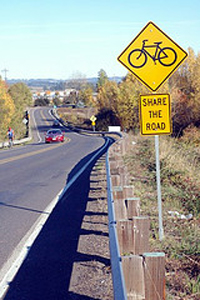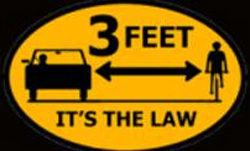The ups and downs of cycling casualties
 Mon, August 10, 2009
Mon, August 10, 2009 
I came across this graph that compares cycling and pedestrian deaths in the US during the period from 1986 to the year 2000.
Over the period pedestrian deaths (Shown in pink.) declined at a fairly steady and consistent rate. I’m not sure the reason; after all motor vehicle traffic has increased and driving standards have certainly decreased over this period.
Does more cars mean less pedestrians, or maybe more cars and the congestion it brings to our cities mean slower traffic, resulting in less pedestrian casualties. Because speed definitely kills those of us unprotected by a steel cage, especially when hit by same steel cage. Or could be pedestrians are just getting street smart.
What I found interesting was the same downward trend for cyclists, but far from being a steady decline it was up and down. Given that there are far more pedestrians than cyclists the chart shows the rate of decline for the two groups.
Starting at the same place in 1986; it showed cycling casualties slightly above the rate of decline for pedestrians at the end of the period.
The article accompanying the chart is about helmet use, and points out that although helmet use went from near zero to 30% in the period, the decline in cycling deaths failed to stay with the decline in pedestrian fatalities. The article doesn’t mention that pedestrian helmet use is still zero.
What immediately struck me was the sharp decline in cycling deaths in 1992; I remember the date well. It was the period when my business went right down the toilet. The reason the quite sudden rise in popularity of the Off Road Mountain Bike, and the accompanying drop in demand for road bikes.
Bicycle dealers nationwide, some almost overnight stopped selling road bikes and switched over exclusively to selling MTBs. It is no wonder cycling deaths dropped so dramatically, cyclists in the US abandoned the roads for dirt trails.
The sharp decline in casualties in 1992 was followed by a dramatic increase in the next five years before moving once again on a steady decline.
My thoughts on this sudden increase; less cyclists on the roads meant that the few diehard roadies left out there were at greater risk for being hit. Out of sight, out of mind as far as the average American driver was concerned, and the motorist doesn't think of cyclists until the moment of impact.
The increase in numbers of cycling deaths in the mid 1990s was even more dramatic when you consider that there were still less people riding on the roads.
I also believe, giving up the roads in the early 1990s also lead to all this hostility towards cyclist. I rode my bike in the US trough the 1980s and agreed there was less traffic, but I never encountered the hostility from drivers there is today.
I quit riding a bike in 1993 when my bike business finally went under, took up running and other forms of exercise, and didn’t start riding again until 2005. It appears this was a good period for me to be off my bike, and off the road.

This more recent article has a chart that goes from 1975 until today. (Shown above.) Interestingly, it shows the sharp decline in 1992, followed by the rise and it would take another ten years before the figures fell below the 1992 level, followed by a sharp increase.
Why this increase? What are your views? Is it because of the increased hostility and poorer driving habits from other road users? Or is it an increase in bicycle riding meaning there are more inexperienced riders on the road?
In conclusion, to get these casualties into perspective; in 2007 there were a total of 41,059 road deaths in the US, according to this article. Pedestrian fatalities showed the same steady decline, down to 4,654, and the number of cyclists killed in 2007 was 698.
This is less than the low point of 723 in 1992, and about the same as the 690 in the year 2000. I haven’t been able to find an accurate count of the number of regular cyclists in the US, but this article suggests that 3.2 million people ride to work at least one day a week. Does anyone have a more accurate count?
My feelings are, helmets may saves lives, but what really saves lives is defensive riding, plus more cyclists on the road leading to more awareness among drivers that there may be cyclists on the road.
 Dave Moulton | Comments Off |
Dave Moulton | Comments Off | 





















Do cyclists need friends like this?
Prof. John Pucher(Above.) is an urban planner at the Bloustein School of Planning and Public Policy, in New Brunswick, New Jersey.
The professor puts out many articles, reports and studies on urban planning in the US, and how the lot in life for cyclists and pedestrians could be improved in American cities.
His plans call for cities with separate bike and pedestrian paths, and he uses as a model, cities in Germany and Holland. He points out that these two countries have far more cyclists and pedestrians, but fewer deaths and injury for the group.
It would appear that Prof. Pucher is the cyclist’s friend. However, the problem I have with the bold professor is that he uses scare tactics in order to push his own agenda. This is not the first time I have called him out for this, I did so in May last year.
He publishes articles and reports that exaggerate the dangers of cycling, and indeed walking in America, in order to push forward his plans to separate cyclists and pedestrians from motor vehicle traffic.
Because he is an “Expert” in his field, his reports get picked up by mainstream media, who then write articles implying that cycling is dangerous, and suggesting maybe cyclists shouldn’t be on the road.
Articles like this one in the New York Times, and this one from the Christian Science Monitor.
In Prof. Pucher’s report, at the bottom of Page 10, he states that per kilometer traveled, pedestrians in the American cities were 23 times more likely to be killed than in a car. Again based on kilometers traveled, cyclists in the US were 12 times more likely to die than a motorist.
As I pointed out in this previous article, you cannot compare injury and fatality rates based on distance traveled, be they kilometers or miles. Cars travel far greater distances than bicycles or pedestrians. The statistic is so flawed it should be ignored entirely.
The professor’s figures seem awfully high when compared to others I have seen, but whatever figures you use, those based on distance are false.
It is not unreasonable for someone to drive 30 miles to work, whereas a for bicycle commuter 6 miles would be reasonable, and a pedestrian 3 miles. This reduces the risk factor for a bicycle by 5 times, and the pedestrian rate by 10 times.
Also, you can’t compare cycling in Germany or Holland with cycling in American cities. These European countries have always had a cycling culture. People there have grown up riding bicycles, and are used to sharing the road with bicycles.
These countries are about the size of a single state in the US; they were built in the Middle Ages and designed around horse drawn transport. They have been forced to adopt a cycling culture because there is less space to drive, let alone park a car.
A few more bike paths and bike lanes would be nice in our cities, and I am all for Prof. Pucher pushing that aspect. But ultimately three things are going make cycling in the US safer; that is education, education, education.
Education for drivers, education for cyclists. TV ads, billboards, etc. would be money well spent. More cyclists on the road will make it safer, we become more visible, and of course more people on bikes, means less people in cars.
There are approximately 700 cyclists die in the US each year; and that’s 700 too many. However, let’s get that figure in perspective. With a population of over 300 million in the US, this number is quite small. It is less than 2 cyclists a day out of tens of thousands who take to the streets on their bike every day; quite a tiny risk I would say.
Cycling is not as dangerous as some would lead us to believe, especially when you consider the alternative of living a sedentary lifestyle and all the adverse health issues that entails.
I am all for separating bikes and cars on busy thoroughfares if at all possible, but at some point cars and bikes have to come together. Most people manage to make their daily commute in their car without running into other cars, how difficult is it NOT to run into someone on a bicycle?
And so Prof. Pucher, while I applaud your efforts to improve cycling in our cities; if you are a true friend of cycling, knock it off with the scare tactics.
You give fuel for the anti-cycling, “Get them off the road” faction, and you scare people away from riding a bike, at a time when we should be encouraging more bicycle riding.
What are your views? Am I being overly critical of Prof. Pucher? What do you think is needed to improve cycling and cycling safety?